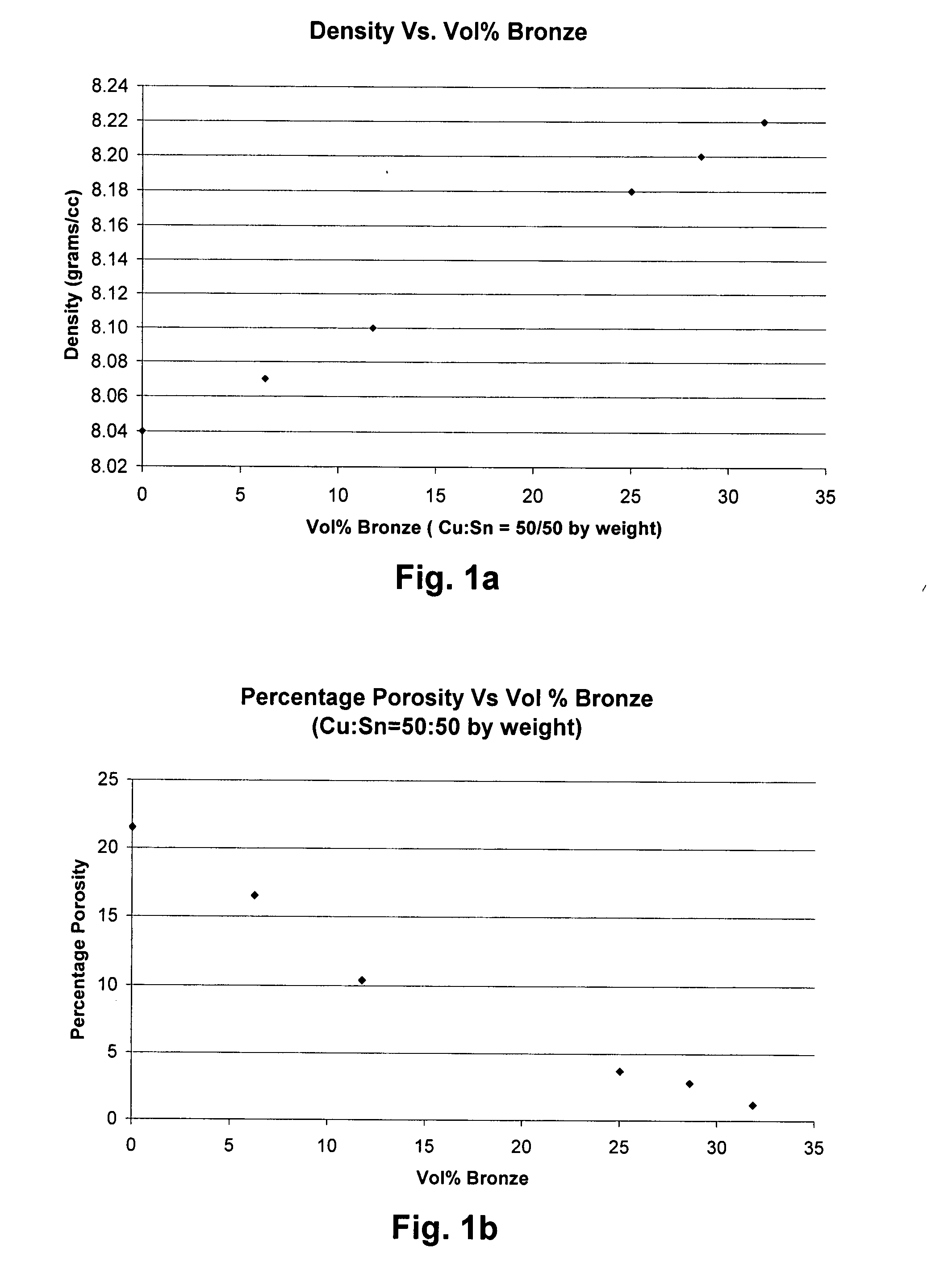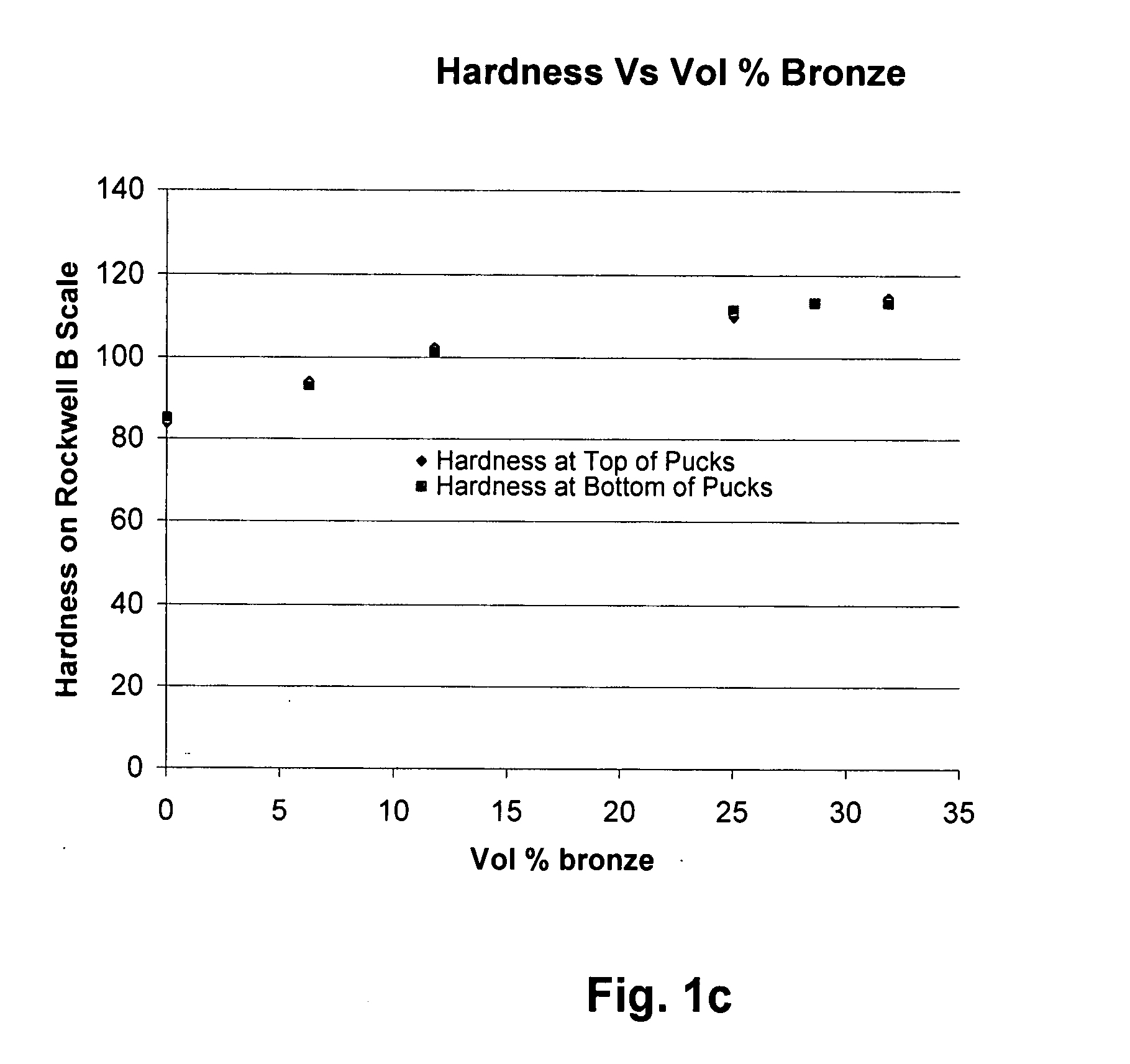Abrasive processing of hard and /or brittle materials
a technology of hard and/or brittle materials and abrasives, which is applied in the direction of grinding devices, manufacturing tools, other chemical processes, etc., can solve the problems of leaving voids or ‘pores’ in the cured abrasive tool
- Summary
- Abstract
- Description
- Claims
- Application Information
AI Technical Summary
Benefits of technology
Problems solved by technology
Method used
Image
Examples
example 1
[0042]A powder metal alloy consisting of nickel, tin and bronze was mixed with fine diamond, salt, and hollow glass spheres. In more detail, 60.93 grams of nickel powder (obtained from AcuPowder International LLC, Union, N.J. as 123 Nickel) was blended with 60.93 grams of tin (also obtained from Acupowder International LLC, Union, N.J. as 115 Tin) and 1.56 grams of diamond (obtained from Diamond Innovations, Worthington, Ohio as RVM-CSG 1-2 microns) in a Turbula® mixer. Then, 52.22 grams of Bronze powder (obtained from United States Bronze Powders, Maryville, Tenn. as M3590 powder) screened to −635 U.S. mesh was added to the mix along with 2.62 grams of hollow glass spheres (obtained from E.V. Roberts Inc, Carson, Calif.) and 91.95 grams of salt (obtained as Diamond Crystal non-iodized salt from Shaw's Supermarkets, Inc, Worcester, Mass. and sized to −70 / +80 U.S. mesh), and Turbula® mixed again to provide a homogenous blend. The resulting mixture included 29.8% of metal bond, 59.6% ...
example 2
[0056]Example 2 refers to an example grinding wheel in accordance with another embodiment of the present invention. In particular, the wheel of Example 2 is similar to the wheel described in Example 1, except there are no glass spheres added in the bond. About 71% salt was introduced in the wheel, which was leached out prior to use. The amounts of various components required to produce the wheel of Example 2 include 58.89 grams of nickel, 58.89 grams of tin, 50.48 grams of bronze, 108.81 grams of salt, and 1.56 grams of diamond.
[0057]A metal bonded segmental wheel fabricated according to Example 2 using the methodology described in Example 1 (“Example 2 wheel”) was tested for finish back-grinding performance of silicon carbide wafers. An initial coarse grind was carried out as previously described with reference to the Example 1 wheel, to remove coarse and relatively large defects on the SiC wafer surface. The grinding conditions were as previously described with reference to Tables...
example 3
[0058]Example 3 refers to an example grinding wheel in accordance with another embodiment of the present invention. In particular, the wheel of Example 3 is similar to the wheel described in Example 1, except that a different type of salt was used. The salt used was single crystal and cubic (obtained as Purex Fine Prepared Salt from Morton Salt Co. Inc, Chicago, Ill. and sized to −70 / +80 U.S. mesh) in contrast to the polycrystalline and irregular shaped salt used in Example 1 (obtained as Diamond Crystal non-iodized salt from Shaw's Supermarkets, Inc, Worcester, Mass. and sized to −70 / +80 U.S. mesh). The amounts of various components required to produce the wheel of Example 3 included 60.93 grams of nickel, 60.93 grams of tin, 52.22 grams of bronze, 91.95 grams of salt, 2.62 grams of glass-spheres, and 1.56 grams of diamond.
[0059]A metal bonded segmental wheel fabricated according to Example 3 using the methodology described in Example 1 (“Example 3 wheel”) was tested for finish bac...
PUM
| Property | Measurement | Unit |
|---|---|---|
| Length | aaaaa | aaaaa |
| Fraction | aaaaa | aaaaa |
| Percent by mass | aaaaa | aaaaa |
Abstract
Description
Claims
Application Information
 Login to View More
Login to View More - R&D
- Intellectual Property
- Life Sciences
- Materials
- Tech Scout
- Unparalleled Data Quality
- Higher Quality Content
- 60% Fewer Hallucinations
Browse by: Latest US Patents, China's latest patents, Technical Efficacy Thesaurus, Application Domain, Technology Topic, Popular Technical Reports.
© 2025 PatSnap. All rights reserved.Legal|Privacy policy|Modern Slavery Act Transparency Statement|Sitemap|About US| Contact US: help@patsnap.com



